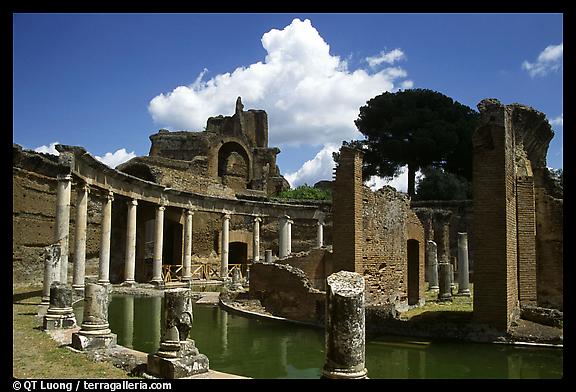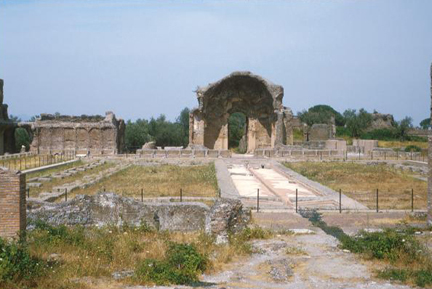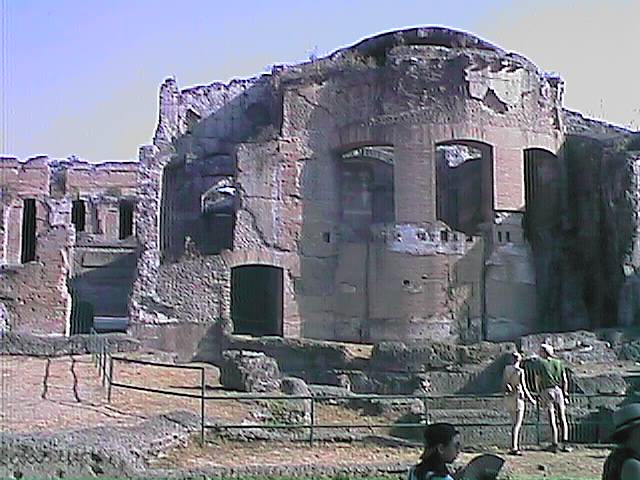|
|
 |
|
Hadrian's Villa: A Roman Masterpiece |
|
written
by somers / 10.04.2004 |
|
|
| |
Description |
| |
| |

|
|
| The Maritime Theater |
| A nice picture of this innovative structure. |
| |
|
| |

|
|
| Piazza d'Oro |
| In the middle, one can see the remnants of the central fountain and pool. Just beyond this is the semi-circular nympheum where water would have been spilling out. |
| |
|
| |

|
|
| The Canopus |
| Notice the alternation between semi-circular and flat on top of the columns. |
| |
|
| |

|
|
| Central Vestibule and Grand Baths |
| This picture shows the central vestibule, the meeting place between the Grand and Small Baths at the Villa. Just behind the vestibule are the Grand Baths where slaves and servants bathed. |
| |
|
Set in the valley below Monti Tiburtini, Hadrian’s choice of location is interesting. Traditional villas, even through the renaissance, were located up on hills where the climate is cooler and the elevation gives the owner perspective as well as protection. Hadrian’s Villa would have been brutally hot in the summer, wet in the winter and without any sort of sweeping view. So why would he choose this site?
Opinions vary, but the most accepted view is that Hadrian’s architectural plans were plain too ambitious to fit on a hillside. The more than thirty massive buildings if placed on a hillside would render walking cumbersome and construction near impossible. The Villa’s tremendous water consumption also meant it had to be close to and below an aqueduct. In fact, Hadrian’s strategic and abundant use of water would more than make up for the warmer temperatures. The site also boasts numerous important building resources including travertine, lime, pozzolana (a type of sand) and tufa. Also worth noting is that the Villa is only 17 roman miles (28 kilometres) from Rome, much closer than had he decided to build up on a hillside.
Two southeast-northwest valleys, almost parallel and five hundred meters apart, define the length of the site. The valleys’ streams, now dry, are bordered by red tufa cliffs, giving the Villa separation and privacy. Between streams, the land is variable and irregular as is common in the Campagna region.
The irregular land therefore dictated the layout of Hadrian’s Villa. Unlike most villas of his age, there is no main or central axis. Rather, the uneven terrain forced the creation of several axes and though most buildings are symmetrical and some buildings are orthogonally related, there appears to be no central organization. Thus, if one were to look at just an aerial overview of the site, it would appear confused and poorly planned. But this was not the case.
To physically describe a site larger, and in some ways more complex, than Pompeii is beyond the scope of this paper. Instead, we will focus on the Villa’s most innovative or unique structures, thereby capturing the importance of Hadrian’s Villa.
The first building we will discuss is the Pecile. It was built to represent the Greek Stoa Poecile in Athens which hosted the greatest Greek paintings. Hadrian’s Pecile probably served the same purpose with its dimensions measuring 232 by 97 meters. If one were to walk around the quadriportico seven times, he would walk two roman miles. This is in accordance with the rules of ambulatio, defined as the doctor recommended distance one should stroll after lunch. It was originally surrounded by four, nine meter walls with a colonnaded interior. These columns, along with the outer walls, supported a wooden roof. Installed in the center of the quadriportico lies a large rectangular pool measuring 100 by 25 meters. It is important to realize that while visiting the Pecile, there would have been four isolating walls, creating peaceful solitude for residents or guests.
Exiting the Pecile in the Northeast corner, one will walk into the Philosophers’ Chamber used for large meetings. This apsidal structure was once covered by a large vaulted ceiling, still somewhat intact today. Underneath the vault are seven niches, each one hosting a different philosopher’s statue. The entire structure was faced in marble, none of which remains today. Also lost, is the coffering that once decorated the ceiling.
Leaving once again to the northeast, we will enter the most famous structure at the Villa: the Maritime Theatre. According the Epistles by Pliny the Younger, it was quite common to build a Villa within a Villa. The Maritime Theatre, also descriptively called the Island Enclosure, is exactly that, only on a grand and revolutionary scale. No comparable structure had been built before this. The large circular enclosure, forty-four meters in diameter (very close to Hadrian’s Pantheon at 43.5 meters) has its main entrance facing north, just as the Pantheon. Just inside the outer wall and surrounding the moat is a ring of forty unfluted Ionic columns. To cross the moat in Hadrian’s day, one would have stepped over wooden draw bridges that could be retracted, now we step over on a cement bridge. Running on a north-south axis, the island contains twenty-two defined spaces. The Room enclosures alternate beteen a semicircular plan and a square plan, an innovative layout unique to Hadrian’s villa. The island includes such facilities as: a lounge, a library with symmetrical side rooms, heated baths with a frigidarium, three suites with heated floors, washbasin, a subterranean art gallery, and a large fountain down the long axis. Connecting the baths to the moat is a stairway suggesting that the moat was also used as a natatio, or swimming pool. Researchers are confident that Hadrian himself designed the island based on his love for architecture, its similarities with the Pantheon and Pliny the Younger’s writing on the subject.
The Hospitalia and Imperial Triclinium form the heart of the Villa, housing and containing offices necessary for imperial business. The white and black mosaic tesserae paving, though some of the best preserved mosaics in the Villa, suggest that this was not in any way occupied by the emperor himself. However, the large atrium suggests that this was the main entrance to the Villa. Central to the function of the Villa, this area contained a library, rooms and many meeting rooms for the many magistrates and bureaucrats.
Just east of the Imperial Triclinium is the Piazza d’Oro. As the name suggests, this is one of the most elaborate and ornate complexes on the grounds. Though centuries of looting and quarrying left it almost bare, during the 18th Century it was here that some of the most important art was found. Imperial portraits, meticulously carved friezes and intricate marble flooring were all found here. Most impressive however was the extensive use of water. At the rear is a large semicircular nympheum from which water poured out of seven niches. The water flowed out of yellow marble set upon purple marble platforms. The water then flowed into the fountains of the central chamber and then flowed down into more minor fountains below. Here in this court, one would be surrounded by lush gardens, impressed by fine statuary and refreshed by the sound of running water.
Just beyond Piazza d’Oro is the Canopus. This long pool, measuring 119 by 18 meters, was built to remind Hadrian of the Canal built between the Nile and Alexandria, one of his favourite cities. The pool was colonnaded and each column was structurally linked to the next with alternating straight and semicircular marble (see picture titled Canopus). At the end is a large nympheum in the form of an exedrae called the Serapeum and would have been used as a dining room. Hadrian’s Villa was known for the parties thrown at the Canopus; it was the place to be.
And, finally, the all-important Roman baths. There are the Small Baths and the Grand Baths, however, again the nomenclature is misleading. The grand baths were larger, less refined and thus used by servants, guards and other middle class workers. The Small baths were sophisticated and one of the most luxurious areas of the Villa. Let us further examine.
The façade is a Republican vestige incorporated into Hadrian’s new Villa. Oriented north, a common theme for Hadrien, one enters into an obviously atypical Roman structure. The octagonal chamber with walls that alternate between flat and concave surface continue Hadrian’s architectural theme. Overhead is a dome ceiling and below are the remnants of opus sectile mosaic. The divergent curvature of this room and the surrounding rooms create an artistic rather than functional environment. The circular planning of the baths is consistent with the other Hadrianic structures, such as the Maritime Theatre, but again is unique. We have no knowledge of any other Villa during this time of similar style. In fact, if one compares the layout of the Villa with its many divergent axis and pools to the floor plan of the Small baths, he will discover that they are strikingly similar, almost as if the baths were a model of the Villa itself.
Left out of this section was Hadrian’s art collection. Thousands of statues, portraits, mosaics, and frescoes have been completely destroyed or stolen from the site. From what we have regrouped into museums today (a good chunk of it’s in the Capitoline!), it is apparent that Hadrian boasted one of the most extensive and varied private art collections of all time. No original art remains at the site today, thus when visiting the Villa, one must keep this in mind and try to imagine the grandiosity of Hadrian’s Villa.
|
| |
|
| |
|
|
 |
|




